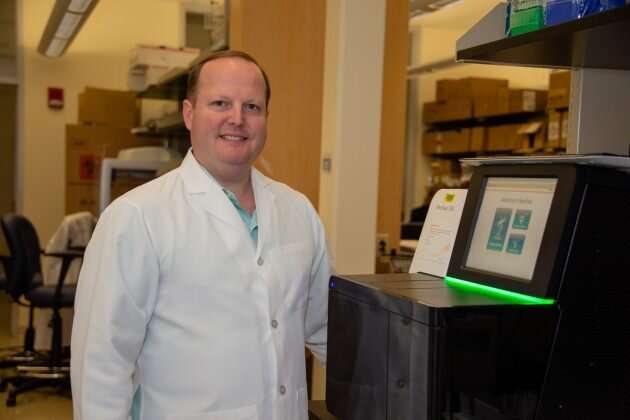
The advent of genome science has given researchers an unprecedented ability to understand the root causes of a host of conditions. Justin Cotney, assistant professor of genetics and genome sciences in the UConn School of Medicine, has used this technology to identify a suite of genes and regulatory elements critical to normal heart development.
In a paper published in the October issue of Circulation Research, Cotney outlines the importance of “hub genes” in heart development. Hub genes operate like the hub of a wheel; they serve as the center from which many other “spokes” radiate and follow their lead in terms of when and to what extent they are expressed.
By studying a massive dataset of 125,000 control patients’ genomes amassed from other studies in the Genome Aggregation Database (gnomAD), Cotney and his team identified a set of genes and regulators critical for heart development. These genes experience infrequent mutations, leading the researchers to conclude they are important to healthy development.
“You can’t be a normal, healthy human with a mutation in these genes,” Cotney says.
The heart develops between the first four to eight weeks of embryonic development. The researchers isolated this timeframe and looked at which parts of the genome were active.
“If you want to understand how the heart is built, that’s where you need to look,” Cotney says.
The genome contains approximately three meters of DNA within the six-micrometer nucleus. This means the DNA must be tightly packed when it is not in use. The researchers used machine learning to determine which sections of the DNA unraveled during this timeframe as indicated by histone modifications.
Cotney’s team identified more than 100,000 regulatory sequences that are active during human heart development. More than 13,000 of these, around 10% of the total, had never been annotated as active in any human tissue or developmental stage. Their analysis of these regulatory elements and gene expression implicated more than 200 novel genes for heart development many likely to involved in congenital heart defects.
“There’s still a lot about the genome we don’t know,” Cotney says.
Since these genes are involved in heart-specific expression, they also play a key role in the development of congenital heart defects, one of the most common birth defects. Other studies of the genetic mechanisms responsible for congenital heart defects have highlighted other genes than the ones captured by Cotney’s study.
“These genes were generally being ignored to date, but we’re saying it’s something people should pay attention to,” Cotney says.
By flagging these genetic elements, clinicians looking at a congenital heart defect patient’s genome can identify which parts of their genome are likely responsible for the condition.
It is unlikely a single mutation causes a congenital heart defect. These genes are part of gene expression networks meaning when a defect occurs, it is likely the result of several related mutations.
Other studies have shown disrupting a single regulator rarely has a noticeable effect on an organism. Many regulatory elements are redundant, so if one is switched off, the organism can still develop normally.
While scientists have developed a rich database on the genes implicated in craniofacial development, that kind of knowledge about the heart is sorely lacking, making Cotney’s work a groundbreaking contribution to the science.
“It’s really one of the most comprehensive studies of chromatin and gene expression during human heart development,” Cotney says.
The researchers have filed a patent for their findings that can be useful for companies that use genetic screening to diagnose congenital heart defects. Until now, they have been looking at other genes which are less precise indicators of the underlying problems. Furthermore, the industry lacks agreement on which genes are most relevant.
“What we found is quite novel,” Cotney says. “We think the combination of these genes will be important in the future for the diagnosis of congenital heart defects.”
The next step for this research is to look at the affected population to see if these genes are mutated as the researchers predict they will be. The team will also conduct experiments mutating certain parts of the genome to determine the influence they have on development.
“I think we’re just scratching the surface,” Cotney says.
These findings also have implications for evolutionary research looking at the hearts of other organisms, as the heart is one of the most rapidly evolving organs.
Source: Read Full Article